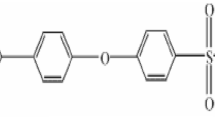Abstract
A new resistance-type sensor based on Prussian blue film has been fabricated for the detection of chlorobenzene vapor. The effect of Prussian blue preparation conditions on the response of sensor was studied. The sensor exhibited good response and selectivity to chlorobenzene vapor. The sensor prepared with Fe2(SO4)3 at 298 K has response 8.5 at operating voltage of 10 V. The selectivity of the sensor to chlorobenzene against all other tested gases is exceeding almost by 5.6 times. The sensor showed linear response to chlorobenzene vapor in the concentration range of 24–169 ppm at room temperature and at a 10 V operating voltage. The response and recovery time of the sensor was about 18 and 12 s, respectively. Sensor stability test indicated the sensor had a good stability. Furthermore, seven real samples of chlorobenzene vapor was measured using the sensor. The relative error was in the range of about ±1.3%.

Response to different gases of the sensor based on Prussian blue prepared with Fe2(SO4)3 at 298 K


Similar content being viewed by others
References
Oh YS, Bartha R (1994) Design and performance of a trickling air biofilter for chlorobenzene and o-dichlorobenzene vapors. Appl Environ Microbiol 60:2717–2722
Reineke W, Knackmuss HJ (1988) Microbial degradation of haloaromatics. Annu Rev Microbiol 42:263–287
Janroelof VDM, Alexander JBZ, Willem MDV (1991) Identification of a novel composite transposable element, tn5280, carrying chlorobenzene dioxygenase genes of Pseudomonas sp. strain p51. J Bacteriol 173:7077–7083
United States Environmental Protection Agency (1995) Pollution Prevention and Toxics. EPA 749-F-95-007a
Sullivan TM, Born CS, Carlson GP, Kessler WV (1983) The pharmacokinetics of inhaled chlorobenzene in the rat. Toxicol Appl Pharmacol 71:194–203
Nair RS, Barter JA, Schroeder RE, Knezevich A, Stack CR (1987) A two-generation reproduction study with monochlorbenzene vapor in rats. Fundament Appl Toxicol 2:678–686
Occupational Safety and Health Administration (1999) Code of Federal Regulations. United States Government Printing Office, Washington, DC
American Conference of Governmental Industrial Hygienists (1993) Threshold Limit Values for Chemical Substances and Physical Agents and Biological Exposure Indices. ACGIH, Cincinnati, OH
Kozani RR, Assadi Y, Shemirani F, Hosseini MRM, Jamali MR (2007) Part-per-trillion determination of chlorobenzenes in water using dispersive liquid–liquid microextraction combined gas chromatography–electron capture detection. Talanta 72:387–393
Riter LS, Charles L, Turowski M, Cooks RG (2001) External interface for trap-and-release membrane introduction mass spectrometry applied to the detection of inorganic chloramines and chlorobenzenes in water. Rapid Commun Mass Spectrom 15:2290–2295
Vidal L, Canals A, Kalogerakis N, Psillakis E (2005) Headspace single-drop microextraction for the analysis of chlorobenzenes in water samples. J Chromatogr A 1089:25–30
Matsunaga N, Sakai G, Shimanoe K, Yamazoe N (2002) Diffusion equation-based study of thin film semiconductor gas sensor-response transient. Sens Actuators B 83:216–221
Barsan N, Schweizer-Berberich M, Gopel W (1999) Fundamental and practical aspects in the design of nanoscaled SnO2 gas sensors: a status report. Fresenius J Anal Chem 365:287–304
Wang X, Yee SS, Carey WP (1995) Transition between neck-controlled and grain- boundary-controlled sensitivity of metal-oxide gas sensors. Sens Actuators B 24:454–457
Korotcenkova G, Cho BK (2009) Thin film SnO2-based gas sensors: film thickness influence. Sens Actuators B 142:321–330
Keith B, Jean-Christophe PG, Mikhail B, Alexander S, George G (2003) Charge transfer from ammonia physisorbed on nanotubes. Phys Rev Lett 91:218301
Horn M, Pichlmatier J (1995) Physical description of the principle of an SO2 sensor. Sens Actuators B 25:400–402
Fu T (2007) Sensing properties and mechanism of gas sensor for H2S and NO2 based on [Cu5(bipyO2)6Cl8]Cl2. Sens Actuators B 123:1113–1119
Author information
Authors and Affiliations
Corresponding author
Rights and permissions
About this article
Cite this article
Fu, T. A gas sensor based on Prussian blue film for the detection of chlorobenzene vapor. Anal Bioanal Chem 401, 1167–1172 (2011). https://doi.org/10.1007/s00216-011-5143-8
Received:
Revised:
Accepted:
Published:
Issue Date:
DOI: https://doi.org/10.1007/s00216-011-5143-8




